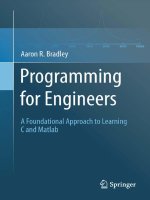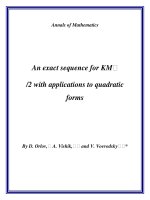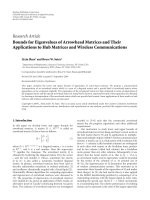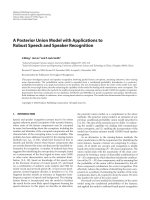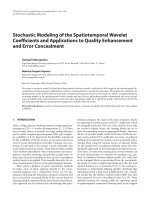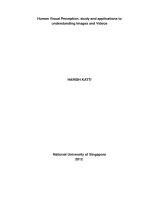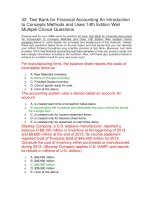LOCALIZED FAILURE FOR COUPLED THERMO-MECHANICS PROBLEMS : APPLICATIONS TO STEEL, CONCRETE AND REINFORCED CONCRETE
Bạn đang xem bản rút gọn của tài liệu. Xem và tải ngay bản đầy đủ của tài liệu tại đây (2.48 MB, 157 trang )
<span class="text_page_counter">Trang 1</span><div class="page_container" data-page="1">
<b>HAL Id: tel-00978452</b>
<small>Submitted on 14 Apr 2014</small>
<b><small>HAL is a multi-disciplinary open access</small></b>
<small>archive for the deposit and dissemination of entific research documents, whether they are pub-lished or not. The documents may come fromteaching and research institutions in France orabroad, or from public or private research centers.</small>
<b><small>sci-L’archive ouverte pluridisciplinaire HAL, est</small></b>
<small>destinée au dépôt et à la diffusion de documentsscientifiques de niveau recherche, publiés ou non,émanant des établissements d’enseignement et derecherche franỗais ou ộtrangers, des laboratoirespublics ou privộs.</small>
<b>problems : applications to steel, concrete and reinforcedconcrete</b>
van Minh Ngo
<b>To cite this version:</b>
<small>van Minh Ngo. Localized failure for coupled thermo-mechanics problems : applications to steel, crete and reinforced concrete. Other. École normale supérieure de Cachan - ENS Cachan, 2013.English. �NNT : 2013DENS0056�. �tel-00978452�</small>
</div><span class="text_page_counter">Trang 2</span><div class="page_container" data-page="2"><b>pour obtenir le grade de </b>
<b>DOCTEUR DE L’ECOLE NORMALE SUPERIEURE DE CACHAN </b>
Adnan IBRAHIMBEGOVIC Professeur, ENS Cachan, Directeur de thèse
LMT-Cachan, ENS CACHAN
61, avenue du Président Wilson, 94235 CACHAN CEDEX (France)
</div><span class="text_page_counter">Trang 3</span><div class="page_container" data-page="3">2
</div><span class="text_page_counter">Trang 4</span><div class="page_container" data-page="4">3
La rupture localisée pour les problèmes couplés
thermomécaniques, applications en béton, acier et béton armé
</div><span class="text_page_counter">Trang 5</span><div class="page_container" data-page="5">4
Ce travail de thèse s‟est déroulé au sein de la groupe „Construction sous conditions extrêmes‟ du Secteur Génie Civil, Laboratoire de Mécanique et Technologie (LMT-Cachan), Ecole Normale Superieure de Cachan. Ces quelques lignes sont dédiées à tous les personnes qui ont contribué de près ou loin d‟aboutissement de cette thèse, en m‟excusant d‟avance auprès de ceux ou celles que je n‟aurais pas eu la délicatesse de mentionner.
Mes premiers remerciment vont à Monsieur Adnan Ibrahimbegovic et Madamme Delphine Brancherie, qui ont initié et encadré mes travaux de thèse. Je leur suis reconnaissant de m‟avoir accordé leur confiance et d‟avoir su partager leur dynamisme et leur excellence scientifique avec une grande attention, faisant de nos rencontres des événements toujours stimulants.
Je tiens à remercier Monsieur Georges Cailletaud d'avoir bien voulu, dans une période chargée, participer à mon jury de thèse et de m'avoir fait l'honneur d'en assurer la présidence. Tous mes remerciements et un respect profond vont également à ceux qui ont accepté la lourde et fastidieuse tâche de rapporter ce travail :Monsieur Luc Davenne et Monsieur Karam Sab. Enfin, je remercie très sincèrement les examinateurs : Monsieur Pierre Villon, Monsieur Christophe Kassiotis et Monsieur Amor Boulkertous d'avoir accepté de participer à l'examen de ce travail. Je voudrais également remercier Monsieur Pierre Jehel, qui a été encadré mes travaux de master avec patience et sympathie.
Je remercie θrofesseur Tran Duc ζhiem, θrofesseur Duong Thi εinh Thu, qui m‟ont démontré la signification d'être un enseignant et un ingénieur civil.
Je remercie Madamme Nitta Ibrahimbegovic pour les bons dinners et les bons sentiments.
Je remercie mes amis: A. Hung, Hieu, Tien, Son, Pierre, Bahar, Nghia, Miha, Edouard, Mijo, Emina, Zvonamir, Bobo, He, Cécile, A.Diep, C. Bich, A. Thanh, C.Ngan, A. Cuong, C. Lan, A. Trang, A. Kien, C.Hoa, C. Thai, Le, A. Hung, C.Hop, Tuan, Lan, Trang, Hung, Thu, Cuong, Huong,… et beaucoup d‟autres. Je me souviendrai du beau temps avec eux à l‟EζS Cachan. Enfin, à ma famille et à Sue je decide cette thèse.
</div><span class="text_page_counter">Trang 6</span><div class="page_container" data-page="6">5 Con cảm ơn bố mẹ đã nuôi nấng, dạy bảo, yêu thương, tin tưởng, động viên, chăm sóc con, vợ chồng con và các cháu trong suốt những năm qua. Cảm ơn bố mẹ đã lo lắng mọi mặt để con có thể yên tâm bước trên con đường của mình. Kết quả nhỏ này con xin gửi tặng bố mẹ.
Con cảm ơn những tình cảm của bố Quyền, mẹ Hạnh và em Trung; cảm ơn bố mẹ và em Trung đã luôn ở bên, thông cảm và giúp đỡ con, Quỳnh và các cháu Bin, Sue trong suốt thời gian con vắng nhà.
Cảm ơn anh chị Nam, Trang và các cháu Bống, Bon đã luôn hỗ trợ, động viên vợ chồng em và cháu Bin. Khơng có các bác và các chị, Bin chắc đã buồn hơn rất nhiều khi bố vắng nhà.
Anh cảm ơn sự hi sinh và tình yêu của Quỳnh. Cho tất cả những gì đã xảy ra, anh xin lỗi vì đã khơng ở bên em q lâu và cảm ơn em đã chăm sóc bố mẹ, chăm sóc các con. Cảm ơn em đã đọc và sửa từng dòng trong quyển luận văn này. Cảm ơn em đã theo dõi từng bước đi, đã vui khi anh có một vài kết quả nhỏ, đã buồn khi anh gặp khó khăn và đã tha thứ mỗi khi anh làm em buồn. Cảm ơn em đã đem Bin và Sue đến trong cuộc sống của chúng ta.
Luận văn này hồn thành là lúc ba có thể về chơi ơ tơ với anh Bin và đón chào sự ra đời của em Sue như ba đã hứa. Ba mẹ và anh Bin tặng luận văn này cho em Sue, thành viên mới trong một gia đình nhỏ mà từ nay sẽ luôn ở gần bên nhau. Ba hứa với các con là chúng ta sẽ ở bên nhau, chắc chắn là như vậy.
</div><span class="text_page_counter">Trang 7</span><div class="page_container" data-page="7">6
During the last decades, the localized failure of massive structures under thermo-mechanical loads becomes the main interest in civil engineering due to a number of construction damaged and collapsed due to fire accident. Two central questions were carried out concerning the theoretical aspect and the solution aspect of the problem.
In the theoretical aspect, the central problem is to introduce a thermo-mechanical model capable of modeling the interaction between these two physical effects, especially in localized failure. Particularly, we have to find the answer to the question: how mechanical loading affect the temperature of the material and inversely, how thermal loading result in the mechanical response of the structure. This question becomes more difficult when considering the localized failure zone, where the classical continuum mechanics theory can not be applied due to the discontinuity in the displacement field and, as will be proved in this thesis, in the heat flow.
In terms of solution aspect, as this multi-physical problem is mathematical represented by a differential system, it can not be solved by an „exact‟ analytical solution and therefore, numerical approximation solution should be carried out.
This thesis contributes to both of these two aspects. Particularly, thermomechanical models for both steel and concrete (the two most important materials in civil engineering), which capable of controling the hardening behavior due to plasticity and/or damage and also the softening behavior due to the localized failure, are carried out and discussed. Then, the thermomechanical problems are solved by „adiabatic‟ operator split procedure, which „separates‟ the multi-physical process into the „mechanical‟ part and the „thermal‟ part. Each part is solved individually by another operator split procedure in the frame-work of embbed-discontinuity finite element method. In which, the „local‟ discontinuities of the displacement field and the heat flow is solved in the element level, for each element where localized failure is detected. Then, these discontinuities are brought into the „static condensation‟ form of the overall equilibrium equation, which is used to solved the displacement field and the temperature field of the structure at the global level.
The thesis also contributes to determine the ultimate response of a reinforced concrete frame submitted to fire loading. In which, we take into account not only the degradation of material properties due to temperature but also the thermal effect in identifying the total response of the
</div><span class="text_page_counter">Trang 8</span><div class="page_container" data-page="8">7 bending failure in forming the overal failure of the reinforced structure.
The thesis can also be extended and completed to solve the behavior of reinforced concrete in 2D or 3D case considering the behavior bond interface or to take into account other type of failures in material such as fatigue or buckling. The proposed models can also be improved to determine the dynamic response of the structure when subjected to earthquake and/or impact.
</div><span class="text_page_counter">Trang 9</span><div class="page_container" data-page="9">8
Ces dernières années, l'étude de la rupture localisée des structures massives sous chargement thermomécanique est devenue un enjeu important en Génie Civil du fait de l'augmentation du nombre de constructions endommagées ou totalement effondrées après un feu. Deux questions centrales ont émergé: la modélisation mathématique des phénomènes mis en jeu lors d'un feu d'une part et la simulation numérique de ces problèmes d'autre part.
Concernant la modélisation mathématique, la principale difficulté est la mise en place de modèles thermomécaniques capables de modéliser le couplage existant entre les effets thermiques et mécaniques, en particulier dans une zone de rupture localisée. Comment le chargement mécanique affecte la distribution de température dans le matériau et inversement, comment le chargement thermique influence la réponse mécanique? Sont des questions qui doivent être abordées. Ces questions sont d'autant plus difficiles à aborder que l'on considère une zone de rupture ó la mécanique des milieux continus classiques ne peut pas être appliquée du fait de la présence de discontinuités du champ de déplacement et, comme cela est démontré dans ce travail, du flux thermique.
Pour ce qui concerne la simulation numérique, la complexité du problème multi-physique posé en termes de système d'équations aux dérivées partielles impose le développement de méthodes de résolution approchées adaptées, efficaces et robustes, la solution analytique n'étant en général pas disponible.
Cette thèse contribue sur tous les deux aspects précédents. En particulier, des modèles thermomécaniques pour le béton et l'acier (les deux principaux matériaux utilisés en Génie Civil) capables de contrơler simultanément les phases d'écrouissage accompagnées de plasticité et/ou d'endommagement diffus, ainsi que la phase adoucissante due au développement de macro-fissures, sont proposés. Le problème thermomécanique est ensuite résolu par une méthode dite «adiabatic operator split» qui consiste à séparer le problème multiphysique en une partie mécanique et une partie thermique. Chaque partie est résolue séparément en utilisant une fois de plus une méthode «d'operator split» dans le cadre des méthodes à discontinuités fortes. Dans ces dernières, une discontinuité du champ de déplacement ou du flux thermique est introduite et gérée au niveau élémentaire du code de calcul Éléments Finis. Une procédure de condensation statique élémentaire permet de prendre en compte ces discontinuités sans modification de
</div><span class="text_page_counter">Trang 10</span><div class="page_container" data-page="10">9 de température.
Dans cette thèse est également abordée la question de l'évaluation de la réponse jusqu'à rupture de structures en béton armé de type poteaux/poutres soumises à un feu. L'originalité de la formulation proposée est de tenir compte de la dégradation des propriétés mécaniques du matériau due au chargement thermique pour la détermination de la résistance limite et résiduelle des structures, mais également de prendre en compte deux types de rupture caractéristiques des structures poteaux/poutres à savoir les ruptures en flexion et les ruptures en cisaillement.
Les travaux présentés dans cette thèse pourront être étendus pour décrire la rupture de structures en béton armé dans des cas bi ou tridimensionnels en tenant compte en particulier du comportement de l'interface acier/béton et/ou d'autres types de rupture comme la rupture par fatigue ou le flambage. Une extension possible est également la prise en compte des effets dynamiques mis en jeu lorsque la structure est sollicitée mécaniquement par un tremblement de terre ou un impact en plus de la sollicitation thermique.
</div><span class="text_page_counter">Trang 11</span><div class="page_container" data-page="11"><small>1.2.1 Previous works on stress-resultant model ... 21 </small>
<small>1.2.2 Previous works on multi-dimensional thermodynamics model ... 22 </small>
<small>1.3 Aims, scope and method ... 24 </small>
<small>1.4 Outline... 25 </small>
<small>2 Thermo-plastic coupling behavior of steel: one-dimensional simulation ... 27 </small>
<small>2.1 Introduction ... 27 </small>
<small>2.2 Theoretical formulation of localized thermo-mechanical coupling problem ... 29 </small>
<small>2.2.1 Continuum thermo-plastic model and its balance equation ... 29 </small>
<small>2.2.2 Thermodynamics model for localized failure and modified balance equation. ... 32 </small>
<small>2.3 Embedded-Discontinuity Finite Element Method (ED-FEM) implementation ... 36 </small>
<small>2.3.1 Domain definition ... 36 </small>
<small>2.3.2 „Adiabatic‟ operator splitting solution procedure ... 37 </small>
<small>2.3.3 Embedded discontinuity finite element implementation for the mechanical part ... 38 </small>
<small>2.3.4 Embedded discontinuity finite element implementation for the thermal part ... 44 </small>
</div><span class="text_page_counter">Trang 12</span><div class="page_container" data-page="12">11
<small>2.4.1 Simple tension imposed temperature example with fixed mesh ... 47 </small>
<small>2.4.2 Mesh refinement, convergence and mesh objectivity ... 61 </small>
<small>2.4.3 Heating effect of mechanical loading ... 62 </small>
<small>2.5 Conclusions ... 64 </small>
<small>3 Behavior of concrete under fully thermo-mechanical coupling conditions ... 66 </small>
<small>3.1 Introduction ... 66 </small>
<small>3.2 General framework ... 67 </small>
<small>3.2.1 General continuum thermodynamic model ... 67 </small>
<small>3.2.2 Localized failure in damage model ... 71 </small>
<small>3.2.3 Discontinuity in the heat flow ... 75 </small>
<small>3.2.4 System of local balance equation ... 76 </small>
<small>3.3 Finite element approximation of the problem ... 76 </small>
<small>3.3.1 Finite element approximation for displacement field ... 76 </small>
<small>3.3.2 Finite element interpolation function for temperature ... 77 </small>
<small>3.3.3 Finite element equation for the problem ... 79 </small>
<small>3.4 Operator split solution procedure ... 82 </small>
<small>3.4.1 Mechanical process ... 83 </small>
<small>3.4.2 Thermal process ... 88 </small>
<small>3.5 Numerical Examples ... 90 </small>
<small>3.5.1 Tension Test and Mesh independency ... 91 </small>
<small>3.5.2 Simple bending test ... 95 </small>
<small>3.5.3 Concrete beam subjected to thermo-mechanical loads ... 99 </small>
<small>3.6 Conclusion ... 103 </small>
<small>4 Thermomechanics failure of reinforced concrete frames ... 104 </small>
<small>4.1 Introduction ... 104 </small>
</div><span class="text_page_counter">Trang 13</span><div class="page_container" data-page="13">12
<small>4.2.1 Stress and strain condition at a position in reinforced concrete beam element under </small>
<small>mechanical and temperature loading. ... 105 </small>
<small>4.2.2 Response of a reinforced concrete element under external loading and fire loading. ... </small>
<small>112 4.2.3 Effect of temperature loading, axial force and shear load on mechanical moment-curvature response of reinforced concrete beam element. ... 116 </small>
<small>4.2.4 Compute the mechanical shear load – shear strain response of a reinforced concrete element subjected to pure shear loading under elevated temperature ... 119 </small>
<small>4.3 Finite element analysis of reinforced concrete frame ... 122 </small>
<small>4.3.1 Timoshenko beam with strong discontinuities ... 122 </small>
<small>4.3.2 Stress-resultant constitutive model for reinforced concrete element ... 125 </small>
<small>4.3.3 Finite element formulation ... 130 </small>
<small>4.4 Numerical example ... 137 </small>
<small>4.4.1 Simple four-point bending test ... 137 </small>
<small>4.4.2 Reinforced concrete frame subjected to fire ... 141 </small>
</div><span class="text_page_counter">Trang 14</span><div class="page_container" data-page="14">13
<i><small>Figure 1-1. Windsor Tower (Madrid) before, in and after fire disater ... 20</small></i>
<i><small>Figure 1-2. Stress-resultant model of a reinforced concrete structure ... 21</small></i>
<i><small>Figure 2-1.Displacement discontinuity at localized failure for the mechanical load ... 33</small></i>
<i><small>Figure 2-2.Displacement discontinuity for 2-node bar element: Heaviside function a d φ x ... 34</small></i>
<i><small>Figure 2-3. Heterogeneous two-phase material for a truss bar, with phase-interface placed at ... 36</small></i>
<i><small>Figure 2-4.Two sub-domain � 1 and � 2 separated by localized failure point at ... 37</small></i>
<i><small>Figure 2-5Displacement discontinuity shape function M</small><sub>1</sub><small>(x) and its derivative. ... 39</small></i>
<i><small>Figure 2-6. Strain discontinuity shape function M2 and its derivative ... 39</small></i>
<i><small>Figure 2-7. Bar subjected to imposed displacement and temperature applied simultaneously ... 47</small></i>
<i><small>Figure 2-8. Time variation of imposed displacement and temperature ... 48</small></i>
<i><small>Figure 2-9. Stress– strain curves in two sub-domains ... 50</small></i>
<i><small>Figure 2-10. Force – displacement curve of the bar ... 50</small></i>
<i><small>Figure 2-11. Distribution of temperature (</small><sup>o</sup><small>C) along the bar at chosen values of time ... 51</small></i>
<i><small>Figure 2-12. Evolutio of Δ versus time (in 0C) ... 52</small></i>
<i><small>Figure 2-13. Stress-strain curves in two sub-domains ... 53</small></i>
<i><small>Figure 2-14. Force displacement curve ... 53</small></i>
<i><small>Figure 2-15. Evolution of temperature (</small><sup>o</sup><small>C) along the bar in time ... 54</small></i>
<i><small>Figure 2-6. Evolutio of Δϑ versus time (in 0C) ... 55</small></i>
<i><small>Figure 2-17.Temperature dependent coefficients (according to [6]) ... 57</small></i>
<i><small>Figure 2-19. Force-displacement diagram for the bar ... 58</small></i>
<i><small>Figure 2-18. Stress-strain curvesfor two sub-domains ... 58</small></i>
<i><small>Figure 2-20. Distribution of temperature (</small><sup>0</sup><small>C) along the bar due to time ... 59</small></i>
<i><small>Figure 2-. Evolutio of Δϑ vs time ... 60</small></i>
<i><small>Figure 2-22.Bar subjected to imposed loading and imposed temperature ... 61</small></i>
<i><small>Figure 2-23. Load-displacement diagram with different number of elements ... 62</small></i>
<i><small>Figure 2-25. Load-displacement curve ... 63</small></i>
<i><small>Figure 2-24. Description of the third example and its mesh ... 63</small></i>
<i><small>Figure 2-26. Temperature evolution along the bar before and after the localized failure occurs (computed with 5 elements mesh) ... 64</small></i>
</div><span class="text_page_counter">Trang 15</span><div class="page_container" data-page="15">14
<i><small>Figure 3-1. Lo alized failure happe s at ra k surfa e a d the lo al zo e ... 71</small></i>
<i><small>Figure 3-2. Additional shape function M</small><sub>1</sub><small>(x) for displacement discontinuity ... 77</small></i>
<i><small>Figure 3-3. Additional shape function ... 78</small></i>
<i><small>Figure 3-4. Adia ati splitti g pro edure. ... 83</small></i>
<i><small>Figure 3-5. Local computation for mechanical part ... 86</small></i>
<i><small>Figure 3-6. Temperature distribution in the plate at t = 20s ... 92</small></i>
<i><small>Figure 3-7. Temperature distribution in the plate at t = 52.4s... 92</small></i>
<i><small>Figure 3-8. Temperature distribution in the plate at t = 100s... 92</small></i>
<i><small>Figure 3-9. Load/Displacement Curve for the coarse and the fine mesh ... 93</small></i>
<i><small>Figure 3-10. Traction - Crack Opening relation at the localized failure ... 93</small></i>
<i><small>Figure 3-11. Load/ Displacement Curve of the plate in thermo-mechanical loadings ... 95</small></i>
<i><small>Figure 3-12. Temperature evolution in the plate for the first loading case (0C) ... 97</small></i>
<i><small>Figure 3-13. Temperature evolution in the plate for the second loading case (</small><sup>0</sup><small>C) ... 97</small></i>
<i><small>Figure 3-14. Evolution of maximum principal stress for the first loading case (MPa) ... 98</small></i>
<i><small>Figure 3-15. Evolution of maximum principal stress for the second loading case (MPa) ... 98</small></i>
<i><small>Figure 3-16. Load/ Displacement curve for 2 loading cases ... 98</small></i>
<i><small>Figure 3-17. Example configuration ... 99</small></i>
<i><small>Figure 3-18. Evolution of maximum principal stress and temperature due to time ... 100</small></i>
<i><small>Figure 3-19. State of the plate at the final loading stage (t = 20s) ... 101</small></i>
<i><small>Figure 3-20. Mechanical and Thermal state of the plate after unloading (t=40s) ... 101</small></i>
<i><small>Figure 3-21. Reaction/ Deflection curve ... 102</small></i>
<i><small>Figure 4-1. Mechanical loading and fire acting on reinforced concrete element ... 106</small></i>
<i><small>Figure 4-2. Thermal stress and thermal strain condition ... 106</small></i>
<i><small>Figure 4-3. Total stress and strain condition at a positio i ea ele e t εy= a d σy=0) ... 107</small></i>
<i><small>Figure 4-4. Mohr circle representation for strain and stress condition at a point in beam element ... 108</small></i>
<i><small>Figure 4-5. Relation between compressive stress and strain of concrete due to tempeture[10] ... 110</small></i>
<i><small>Figure 4-6. Stress- strain relationship of rebar in different temperature... 112</small></i>
<i><small>Figure 4-7. Response of reinforced concrete element under mechanical and thermal loads ... 113</small></i>
</div><span class="text_page_counter">Trang 16</span><div class="page_container" data-page="16">15
<i><small>Figure 4-10. Evolution of temperature profile due to time[11] ... 116</small></i>
<i><small>Figure 4-11. Dependence of moment-curvature with time exposure to fire ASTM119 ... 117</small></i>
<i><small>Figure 4-12. Dependence of moment-curvature on axial compression ... 117</small></i>
<i><small>Figure 4-13. Dependence of moment-curvature response on shear loading ... 118</small></i>
<i><small>Figure 4-14. Multi-linear moment-curvature model of the reinforced concrete beam in bending ... 119</small></i>
<i><small>Figure 4-15. Stress components of reinforced concrete subjected to pure shear loading ... 120</small></i>
<i><small>Figure 4-16. Mechanical shear force- shear deformation diagram ... 121</small></i>
<i><small>Figure 4-17. Beam under external loading and fire ... 122</small></i>
<i><small>Figure 4-18. Kinematic of beam element ... 124</small></i>
<i><small>Figure 4-19. Moment-curvature relation for bending stress-resultant model ... 128</small></i>
<i><small>Figure 4-20. Shear load-shear strain relation for shear stress-resultant model ... 130</small></i>
<i><small>Figure 4-21. Simple reinforced concrete beam subjected to ASTM 119 fire and vertical forces ... 137</small></i>
<i><small>Figure 4-22. Reduction of bending resistance due to time exposing to fire ASTM 119 ... 138</small></i>
<i><small>Figure 4-23. Reduction of shear resistance due to time exposing to fire ASTM 119 ... 139</small></i>
<i><small>Figure 4-24. Force/displacement curve of the beam at different instants of fire loading program ... 140</small></i>
<i><small>Figure 4-25. Reduction of ultimate load due to fire exposure ... 141</small></i>
<i><small>Figure 4-26. Two-story reinforced concrete frame subjected to loading and fire ... 142</small></i>
<i><small>Figure 4-27. Temperature profile of the reinforced concrete beam due to time of fire ... 143</small></i>
<i><small>Figure 4-28. Moment-curvature model for column ... 144</small></i>
<i><small>Figure 4-29. Shear failure model of the column... 144</small></i>
<i><small>Figure 4-30. Degradation of bending resistance of reinforced concrete beam versus fire exposure... 145</small></i>
<i><small>Figure 4-31.Horizontal force/displacement curve of two-story frame at different instants of fire ... 145</small></i>
</div><span class="text_page_counter">Trang 17</span><div class="page_container" data-page="17">16
<i><small>Table 1-1. Several building fire accidents from 1970 to present (see [4])... 19</small></i>
<i><small>Table 2-1. Material properties of steel bar ... 49</small></i>
<i><small>Table 2-2.Time Evolution of Temperature along the Bar ... 51</small></i>
<i><small>Table 2-3.Time evolution of temperature along the bar ... 54</small></i>
<i><small>Table 2-4. Temperature dependent coefficients ... 56</small></i>
<i><small>Table 2-5. Distribution of temperature along the bar ... 59</small></i>
<i><small>Table 2-6. Material properties ... 61</small></i>
<i><small>Table 3-1. Material Properties ... 91</small></i>
<i><small>Table 4-1. List of symbols for thermomechanical model ... 105</small></i>
<i><small>Table 4-2. Bending model parameters for different instants of fire loading program ... 138</small></i>
<i><small>Table 4-3. Parameters of shear model at different instants of fire loading program ... 139</small></i>
<i><small>Table 4-4. Material properties ... 143</small></i>
</div><span class="text_page_counter">Trang 18</span><div class="page_container" data-page="18">17
<b><small>Journals </small></b>
<small>[1] V.M. Ngo, A. Ibrahimbegovic, and D. Brancherie, "Model for localized failure with thermo-plastic </small>
<i><small>coupling. Theoretical formulation and ED-FEM implementation," Computers and Structures, vol. 127, </small></i>
<small>pp. 2-18, 2013. </small>
<small>[2] M. Ngo, A. Ibrahimbegovic, and D. Brancherie, "Continuum damage model for thermo-mechanical </small>
<i><small>coupling in quasi-brittle materials," Engineering Structure, vol. 50, pp. 170-178, 2013. </small></i>
<small>[γ] ε. ζgo, A. Ibrahimbegovic, and D. Brancherie, “Softening behavior of quasi-brittle material under full thermo-mechanical coupling condition: Theoretical formulation and finite element implementation</small><b><small>,” </small></b>
<i><small>Computer Methods in Applied Mechanics and Engineering</small></i><small>, Accepted. </small>
<small>[4] N.N Bui, M. Ngo, D. Brancherie, and A. Ibrahimbegovic, "Enriched Timoshenko beam finite element </small>
<i><small>for modelling bending and shear failure of reinforced concrete frames," Computer and Structures, </small></i>
<small>Submitted. </small>
<small>[5] ε. ζgo, A. Ibrahimbegovic, and D. Brancherie, “Thermomechanics Failure of Reinforced Concrete Composites: Computational Approach with Enhanced Beam Model</small><i><b><small>,” Computer and Concretes, </small></b></i>
<small>Submitted. </small>
<small>[6] M.Ngo, A. Ibrahimbegovic and E. Hajdo, “δocalized failure for large deformation of thermo-plasticity </small>
<i><small>problem,” Nonlinear Coupled Mechanic System, Submitted. </small></i>
<b><small>Conferences and Workshops </small></b>
<b><small>1. V.M. Ngo, P. Jehel, A. Ibrahimbegovic </small></b><small>“Numerical modelling of monotonic and cyclic response of anchorage steel bar,</small><i><small>” Workshop on Construction under Exceptional Conditions (CEC 2010), </small></i>
<small>Hanoi,October, 2010. </small>
<i><small>2. M. Ngo, A. Ibrahimbegovic, and D. Brancherie , “A thermo-damage coupling model for concrete </small></i>
<small>structure</small><i><small>,” 7th International Conference on Computational Mechanics for Spatial Structures. IASS-IACM </small></i>
<i><small>2012</small></i><small>, Sarajevo, April 2-4, 2012. </small>
<small>3. M. Ngo, A. Ibrahimbegovic, and D. Brancherie “Continuum damage model for thermo-mechanical coupling in quasi-brittle materials,</small><i><b><small>” The first AVSE Annual Doctoral Workshop. ENS Cachan, Cachan, </small></b></i>
<small>September 13-14, 2012. </small>
</div><span class="text_page_counter">Trang 19</span><div class="page_container" data-page="19">18
<b>1 Introduction </b>
<b>1.1 Problem statement and its importance </b>
The characterization of the failure in steel, concrete and reinforced concrete structures under thermo-mechanical loading is not only the main theoretical importance but also the major interest for its practical application. In recent years, the number of massive constructions collapsed and/or damaged due to fire loading is increasing. A list of several major building fire accidents from 1970 onwards (given in Table 1-1) has indicated the progress of them in term of number and severity. Among these accidents, perhaps the most well-known is the collapse of the World Trade Centre in New York in September, 2001, where the thermal response and the degradation of material properties due to fire were considerably contributed into the final breakdown of the tower in addition to the mechanical response due to the airplane impact (see [1], [2], [3]). More recently, the burning occurred in the 32-storey Windsor tower in Madrid, Spain in February, 2005 (see Figure 1-1) is also a typical example of construction failure due to fire loading. In this accident, the fire started on the 21<sup>st</sup> floor then quickly spread throughout the entire building. After 24 hours exposure to fire, the steel components of the tower were destroyed while the reinforced concrete components were also partially damaged. Although not being completely destroyed in the fire, the remaining reinforced concrete structures had also lost its working capacity and had to be demolished later. These structural failures, from the civil engineering point of view, happened due to the lack of structure resistance, or more particularly, the degradation of structure resistance when exposed to extreme thermal loads. This issue is still not clearly understood presently. Therefore, it is necessary to go into deeper studies of the behavior of structure subjected to thermal loading and mechanical loading simultaneously. Of special interest is the problem of localized failure of the structure at extreme conditions that can produce the localized heavily damaged zones leading to structure softening response. In this thesis, the localized failure of structures built of standard construction materials, such as steel, concrete and reinforced concrete will be discussed. The main target, as will be explained in more detail in the following, is to provide a more robustness simulation of the „ultimate‟ response of reinforced concrete structure, which will further lead to a better and safer design of the
<b>construction. </b>
</div><span class="text_page_counter">Trang 20</span><div class="page_container" data-page="20">19
<i><b>Table 1-1. Several building fire accidents from 1970 to present (see [4]) </b></i>
<small>1 One New York Plaza, New York, USA </small>
<small>50-storey office building 2 persons died </small>
<small>California, USA </small>
<small>62-storey building One person died </small>
<small>Airpcarft impacted and then Fire happened </small>
<small>Nearly 3000 persons died </small>
<small>Building, Chicago, Illinois , USA </small>
<small>9 Caracas Tower , Caracas, Venezuela 56-storey, 220 m high tower. Tower was burned for more than 17 hours before collapsing </small>
</div><span class="text_page_counter">Trang 21</span><div class="page_container" data-page="21">The stress resultant model considers the structure as a system of one-dimensional elements: beams, frames, columns, trusses. (see Figure 1-2). These elements, due to their special configurations with one dimension being much greater than the two others, are assumed to satisfy traditional hypotheses of the structural analysis such as the Saint-Venant hypothesis:
<i>„…the difference between the effects of two different but statically equivalent loads becomes very </i>
<i>small at sufficiently large distances from load‟ (see [5]) and the beam theory assumptionsμ „beam </i>
<i>is initial straight and has a constant cross-section‟, „the plane cross-section remains plane before and afterloading</i>‟. Due to the simplicity and the low-cost of computation, this type of approach is widely used in practical design of reinfored concrete as well as steel structures submitted to combined action of fire and mechanical loading. Such is still the basic method introduced in the design code of Europe and America nowadays (see [6],[7], [8], [9], [10], [11]). However, despite the forementioned avantages, the stress-resultant model can not be applied for the „local‟ regions (or the „D‟ regions [12], [9]) of the structure where the Saint-Venant and
</div><span class="text_page_counter">Trang 22</span><div class="page_container" data-page="22">21 beam hypotheses are no longer valid. Examples of this kind are the beam-column joint or the footing region (see Figure 1-2).
The latter approach, which is now developing very fast due to the development of computers, is to treat the structure as a multi-dimensional media subjected to external thermo-mechanical. This type of computation further leads to the needs of: 1) a thermo-mechanical model which is capable of modeling the response of steel and concrete material under the combining effect of thermal and mechanical loading; 2) a robust numerical solution procedure to solve such a multi-physical problem. Although this type of approach leads to a much higher calculation cost in comparison to the stress-resultant approach, it will certainly provide better results, especially when modeling the local region of the structure.
<b>1.2.1 Previous works on stress-resultant model </b>
The analysis combining thermo-mechanical response of reinforced concrete frame structure based on the stress-resultant model were entirely studied by many researchers and many interesting results were introduced. Among them, one can refer to the work of Kodur and Dwaikat (see [13], [14]), Hsu and Lin ([15]) or Capua and Mari ([16]). However, most of these studies considered only the bending failure and ignored the shear failure, which is also a typical damage model of the reinforced concrete structure. Moreover, practically none of the works available in the literatures considers the effect of shear force and axial force on the bending
<i><b>Figure 1-2. Stress-resultant model of a reinforced concrete structure </b></i>
<small>400 1600 </small>
<small>4600 </small>
<small>400 </small>
<small>3100 </small> <sup>400 </sup>
Local region
</div><span class="text_page_counter">Trang 23</span><div class="page_container" data-page="23">22
resistance of reinforced concrete element, although the stress-strain relation of the cross-section where shear force and axial force exist are much different from the stress/strain condition of the pure bending cross-section. Another deficiency of previously proposed methods is that only the degradation of the mechanical resistance due to material strength reduction at high temperature is taken into account, while the „thermal‟ response of the frame is usually neglected while at high temperature, thermal behavior might significantly contribute to the total behavior of the section. The last important model feature to be improved with respect to the previous works is to cast the stress-resultant model that can represent such a thermomechanical behavior of a reinforced concrete elements (either beam or column), which can provide an efficient computational basis in identifying the overall response of the frame structure. Therefore, a method to overcome the mentioned shortcomings of the present stress-resultant based model will be introduced in this thesis.
<b>1.2.2 Previous works on multi-dimensional thermodynamics model </b>
As already declared, the multi-dimensional analysis of „local‟ regions should be based on a thermo-mechanical model of steel and concrete material. In the following, some main contributions on the modeling of softening behavior of construction material due to mechanical effect only and due to thermo-mechanical coupling effect are summarized.
The „ultimate‟ resistance of structures under mechanical loading was previously studied by many research groups, by using a number of different approaches. The research group entitled „Structure under Extreme Conditions‟ of θrofessor Ibrahimbegovic at δεT Cachan contributed to this topic by considering the softening behavior of material in the frame-work of Embedded-Discontinuity Finite Element Method (see [17]). Here, the localized failure of the solid is represented as a „discontinuity‟ (or a „jump‟) in displacement field and is modeled by an additional interpolation function using the incompatible mode in finite element method [18]. Based on this method, this research group contributed in determining the softening behavior of the structure due to both the stress-resultant model approach and the multi-dimensional analysis approach. For the stress-resultant model approach, one can refer to the study on the bending failure frame (see [19],[20]) and/or the bending failure accompanied with shear failure (see [21]) of reinforced concrete frame. In terms of the multi-dimensional analysis approach, the thermomechanical softening model of some fundamental construction materials were introduced:
</div><span class="text_page_counter">Trang 24</span><div class="page_container" data-page="24">23 elasto-plastic steel material structure (see [22],[23]), quasi-brittle material (concrete, masonry) (see [24], [25]) and reinforced concrete structures (see [26]). Other (and earlier) significant contributions to the topic that should be recalled are the work of Ortiz el al. on weak discontinuity (see [27]) and of Simo et al., Armero et al. and Oliver et al. on strong discontinuity of material (see [28], [29], [30], [31], [32]). These methods are based on a modification of classical continuum models and provide an adequate measure of the dissipation with respect to the chosen finite element discretization. However, they only consider the combination of the discontinuity with an elastic behavior of the material without taking into account the continuum inelastic behavior of the material. Therefore, these models are not actually suitable to be used in modeling the working of steel and concrete structures, since the plastic behavior and damage behavior play an important role in the total behavior of these materials.
The behavior of material under thermal loading only, or in other words, the heat transfer problem was a classical topic and was thoroughly studied. However, the coupling effect of mechanical loading and thermal loading on material was not much studied, both in terms of theoretical formulation and numerical solution. In terms of theoretical aspect, we can recall several important works of Armero and Simo (see [33]) on nonlinear coupled plasticity for small deformation, of Ibrahimbegovic et al. (see [34], [35]) on thermo-plastic coupling with large deformation, of Baker and de Borst (see [36]) on anisotropic thermomechanical damage model for concrete and of Tran and Sab (see [37]) on steel-concrete bonding interface. These works are limited to the behavior of material in classical continuum mechanical framework and thus are not able to model the behavior of solid at localized failure where „discontinuity‟ appears in the displacement field.
We also note that in the framework of continuum mechanics, there is not much research considering the numerical solution for the problem of computing the localized failure and associated softening response due to coupled thermomechanical loads. The latter especially applies to quasi-brittle material models, which are generally the most popular for representing the mechanical behavior of construction materials employed in civil engineering nowadays. The softening behavior of material under the fully thermo-mechanical coupling effects was analyzed by very few previous research works, and also for only special cases. For example, in 1999, Runesson and coworkers (see [38]) studied the theoretical aspect of the localization in
</div><span class="text_page_counter">Trang 25</span><div class="page_container" data-page="25">24
thermo-elastoplastic solids subjected to adiabatic condition, which is a really „ideal‟ case of loading. This work has more a theoretical meaning than a practical application and need to be extended. In 2002, a one-dimensional analysis of strain localization in a shear layer under thermally coupled dynamic conditions was introduced by Armero and Park (see [39]). In that work, an analytical solution for the localization of a one-dimensional shear layer was discussed in detail. However, due to the limitation of analytical approach, this method cannot be extended
<i>to higher-dimensional problems. We can also mention the work of Wiliam et al. in 2004 (see </i>
[40]) who studied the interface damage model for thermomechanical degradation of heterogeneous materials. However, this work does not include a clear numerical solution for the model and thus, its application is limited to fairly simple problems.
<b>1.3 Aims, scope and method </b>
The first target of this thesis is to improve the present stress-resultant model in determining the overall behavior of the reinforced concrete structure. In order to do so, two central problems should be considered: 1) how to take into account the shear failure (along with the bending failure) into the overall failure of the reinforced concrete frame; 2) how to evaluate and account for the cumulative effect of thermal loading on the total response of the structure. In this thesis, the answers to these questions are found by the following procedure. First, we use the Modified Compression Theory (see [41]) to construct the stress-strain conditions of the considered beam element under different mechanical and temperature loadings. Based on the chosen stress-strain relations of the beam ingredients, we plot its bending-curvature and shear force-shear strain curve at a given temperature loading. These curves are then treated as input parameters of a beam stress-resultant model, which can finally be solved by the embedded-discontinuity finite element analysis.
The second (and also the main) goal of the thesis is to provide a thermodynamic model capable of considering the ultimate load behavior accompanied by softening phenomena not only due to mechanical loading but also to fully coupled thermomechanical condition. Both plasticity and damage models of this kind are developed in this thesis. Regarding the numerical implementation, two important tasks are examined in detail. The first one is the numerical solution of the problem. As explained in the following, the mathematical representation of thermo-mechanical problem is a system of differential equations with unknowns pertaining to
</div><span class="text_page_counter">Trang 26</span><div class="page_container" data-page="26">25 mechanical fields (displacement, strain, stress) and thermal fields (temperature, heat flux). Such a system normally does not have an „exact‟ analytical solution except for some of the simplest one-dimensional cases. In general, an approximate numerical solution for the problem should be introduced. We propose and discuss, in particular, the operator split solution procedure, which is adapted to both initial hardening behavior and subsequent softening behavior of the thermoplastic or thermo-damage solid mechanics models. The latter is one of the most complex tasks when considering the aspects of numerical implementation in the thesis. The second objective is to examine the softening behavior of the solids under fully coupled thermomechanical extreme conditions. To that end, the first challenge is pick the right thermo-mechanical model for either quasi-brittle or ductile failure phenomena and validate the choice. Two models describing the corresponding inelastic behavior of solids are chosen: the thermo-plasticity and thermo-damage. These two correspond to typical choices made for the construction materials like steel and concrete. These models are carefully assembled within a complex model corresponding to the reinforced concrete composite. We also develop a more efficient structural-type model for reinforced concrete in terms of the Timoshenko beam formulation. The final challenge we address concerns the appropriate choice of the enhanced kinematics to be introduced at the point of localized failure. This has been done in a systematic manner for different models developed in this thesis.
<b>1.4 Outline </b>
The outline of the thesis is as follows. In the next chapter, we present the general theoretical formulation for the problem in solid mechanics subjected to thermo-mechanical actions and the approximation numerical solution. This general method is applied in detail to model the localization on elasto-plastic material such as steel in Chapter 2. One-dimensional case will be considered in this chapter in order to show a clear overview of the method. The third chapter considers the continuum damage and also the degradation of quasi-brittle material like concrete or masonry in multi-dimensional problem. This chapter removes two deficiencies of the existing documents on thermomechanical coupling reaction of quasi-brittle material, which are the numerical solution for continuum damage threshold and the model for the softening behavior of this material. Theoretical model and a numerical solution of the „ultimate‟ response of reinforced concrete structure subjected to thermal loading and mechanical loading applying
</div><span class="text_page_counter">Trang 27</span><div class="page_container" data-page="27">26
simultaneously based on Timoshenko beam formulation is carried out in the fourth chapter. Finally, the conclusion summarizes all the main findings of the thesis and suggests the perspective of the study on this topic in the future.
</div><span class="text_page_counter">Trang 28</span><div class="page_container" data-page="28">None of these existing models can be applied to estimate the ultimate thermo-mechanical state of a complex structure, with the for a localized failure number of components. In such a case, it is necessary to provide a model capable of representing the thermomechanical behavior of the material in localization zone. Even for purely mechanical loading, where the material propertiesare considered to be independent of temperature, one already needs a special model formulation to capture localized failure with adding either strong displacement discontinuity for brittle failure (see [32], [29], [31]) or fracture process zone with hardening and displacement discontinuity with softening for ductile failure ([23], [25]). The new issue for coupled thermomechanics problem concerns the heat transfers and temperature changes in the localized failure zone. Only a couple of recent works tried to answer this question, resulting from opposing views. More precisely, Armero and Park ([39]) consider an elastic rectangular shear layer subjected to a propagation of stress wave from its two ends, leading to a strong displacement discontinuity in the middle, accompanied with a jump in the heat flux through the localization zone. In contrast with this hypothesis, Runesson et al. ([38]) considered the adiabatic condition with the material properties (i.e. heat capacity) at failure zone assumed to remain similar to the non-failure zone, leading to a jump in temperature field in the localized failure zone to accompany the displacement discontinuity. Neither fracture process zone, nor the temperature dependent material properties is considered in these works.
</div><span class="text_page_counter">Trang 29</span><div class="page_container" data-page="29">28
Thus, the first main target of this chapter is to provide the theoretical formulation for a coupled thermo-mechanical failure problem that can take into account both the fracture process zone and softening behavior at localized failure zone. We provide perhaps „the best choice‟ compromise for describing the localized thermo-mechanical failure, introducing the displacement and deformation discontinuity for the mechanical part along with the discontinuity in temperature gradient for the thermal part. The proper justification for this choice based upon the adiabatic split is also provided. Another main aim of this chapter is to provide a very careful consideration of finite element approximation in the presence of thermo-mechanical coupling and localized failure which allows us to use the structured mesh. Here, we choose enhancement of strain field to accompany displacement discontinuity, which is needed to accommodate the temperature dependent material properties in the fracture process zone in the presence of non-homogeneous temperature field induced by localized failure. For clarity, in this chaper, the development is presented in detail for a one-dimensional bar subjected to static mechanical loading coupled with temperature transfer from one end to the other.
The efficiency of our numerical implementation is ensured by using the structured finite element mesh, which is constructed by employing the finite element methods with embedded discontinuities (ED-FEM). As explained by Ibrahimbegovic and Melnyk in [22], the proposed ED-FEM is proved to be a very successful alternative to the extended finite element method or X-FEM (see[48]), providing higher computational robustness with the discontinuities in displacement and in heat flux defined at the element level. The same helps to better separate the roles of strain versus displacement discontinuities, and considerably simplifies the numerical implementation within the standard computer code architecture.
The outline of this chapter is as follows. In Section 2.2, we provide the theoretical formulation of thermo-plastic model for localized failure in the one-dimensional framework. The embedded-discontinuity finite element method (ED-FEM) implementation for the problem is presented in Section 2.3. Several numerical simulations and illustrative results for 1D problem are given in Section 2.4. Conclusions and discussions are stated in Section 2.5.
</div><span class="text_page_counter">Trang 30</span><div class="page_container" data-page="30"><i> </i>
(2-1)
<i>Where E is the Young modulus, is the total strain,</i> is the plastic strain, is the stress-like <i><small>p</small></i>
variable associated to hardening, � is the hardening variable, � is the mass density, is the temperature, <sub>0</sub> is the reference temperature, is the density heat capacity and is the coefficient that gives the relation between stress and temperature. In this work, we consider that the mechanical properties are temperature dependent.
The state equations are given by
</div><span class="text_page_counter">Trang 31</span><div class="page_container" data-page="31">− <small>�</small>
− <small>−�</small>
− <sub>�</sub><small>−</small>
where � and K are the values at the reference temperature <small>0</small>.
The evolution laws of the state variables are established by the second law of thermodynamics, in which the internal dissipation reaches the maximum value. In particular, the Kuhn – Tucker
<i>condition is used to find the maximum of internal dissipation D<small>int</small></i> among the admissible stress values with �(�, , ) 0. This can be defined as the corresponding constrained minimization: max �, ,
<small>� �, , 0</small>
</div><span class="text_page_counter">Trang 32</span><div class="page_container" data-page="32">31
where is the Lagrange multiplier.
The balance equations for the problem are obtained by using the force equilibrium equation and the first principle of thermodynamics. The force equilibrium equation can be written as:
+ <small>−�</small>
+<small>�−</small>
</div><span class="text_page_counter">Trang 33</span><div class="page_container" data-page="33"><i>Dirac delta function: </i>
</div><span class="text_page_counter">Trang 34</span><div class="page_container" data-page="34">33 The mechanical properties at localized failure are assumed to have the same dependence on temperature as the bulk part; hence, we can write:
where � and are, respectively, the ultimate stress and softening modulus at reference temperature <sub>0</sub>.
<b>Figure 2-1</b><i><b>.Displacement discontinuity at localized failure for the mechanical load </b></i>
Once the localized failure occurs, the crack opening (further denoted as ( ), seeFigure 2-1) contributes to a “jump” or irregular part in the displacement field. The total displacement field is thus sum of regular (smooth) part and irregular part:
</div><span class="text_page_counter">Trang 35</span><div class="page_container" data-page="35">34
<b>Figure 2-2</b><i>.Displacement discontinuity for 2-node bar element: Heaviside function </i> <sub>� </sub><i><b>and (x) </b></i>
Denoting with , = , − �( ) the continuous part of the displacement field, and with ( )the “jump” in displacement, we can further write additive decomposition of displacement field:
</div><span class="text_page_counter">Trang 36</span><div class="page_container" data-page="36">35 <small>Ω</small> <sub>= </sub>
where is the plastic multiplier at the point of localized failure.
<i><b>2.2.2.2 Thermo-mechanical balance equation </b></i>
The set of force equilibrium equations consists of two equations:
<b>(1) the local force equilibrium (established for all the bulk domain) </b>
the stress orthogonality condition to define the traction at localized failure point
<b>(2) Local balance of energy at the localized failure point </b>
For the regular part, the local energy balance is still described by continuum thermodynamic model (2-21): = − + +
The corresponding state equation (2-3) reads: =− = − + �
</div><span class="text_page_counter">Trang 37</span><div class="page_container" data-page="37">36
mechanical dissipation at localized failure can be balanced only against the change of heat flux. Moreover, the local energy balance equation at the localized failure point ought to be interpreted in the distribution sense, resulting with the corresponding jump in the heat flux:
where the mechanical dissipation acts as the heat source at the failure point. As indicated in (2-21) to (2-4γ) above, this results in the corresponding “jump” of the heat flux through the localized failure section. We note in passing that the jump in the heat flux leads to a change of the temperature gradient at the localized point. In the finite element implementation, one needs additional shape functions for describing not only displacement but also temperature field, as described in the following.
<b>2.3 Embedded-Discontinuity Finite Element Method (ED-FEM) implementation 2.3.1 Domain definition </b>
<i><b>Figure 2-3. Heterogeneous two-phase material for a truss bar, with phase-interface placed at </b></i>� We consider a 1D heterogeneous truss-bar subjected simultaneously to mechanical loading (including distributed load b(x) and prescribed displacements at both ends) and heat transfer along the bar (Figure 2-3). The material heterogeneity is the direct result of temperature dependent material parameters under heterogeneous temperature field. In particular, we consider that the bar is built of an elasto-plastic material, occupying two different sub-domains separated by localized failure point at :
</div><span class="text_page_counter">Trang 38</span><div class="page_container" data-page="38">37 In the following, the indices “1” is used for all the thermodynamics variables relate to sub-domain Ω<small>1</small>, and the indices “β” to the second sub-domain Ω<small>2</small>.
<b>2.3.2 „Adiabatic‟ operator splitting solution procedure </b>
Due to the positive experience of Kassiotis et al. (see [50]), we choose the operator split method based upon adiabatic split to solve this problem. In the most general case with active localized failure, the coupled thermomechanical problem is described by a set of mechanical balance equations defined in (2-39) and (2-40), accompanied by the energy balance equations in (2-42) and (2-43). Solving all of these equations simultaneously is certainly not the most efficient option. In order to increase the solution efficiency, we can choose between two possible operator split implementations: isothermal and adiabatic (see [17]). We note in passing that the isothermal operator split is not capable of providing the stability of the computation (see [50]). Therefore,
<i>we focus only upon the adiabatic operator split method. In this method, the problem is divided </i>
into two phases, with each one contribution to change of temperature:
<b>Phase 1 - Mechanical part </b>
<b>with “adiabatic”condition <sup>Phase 2- Thermal part </sup></b>
0 = �+
= 0 → � = − −
(at localized failure point): �<small>1|</small> = �<small>2|</small> =
� = − + = |
The computations of the mechanical and thermal states remain coupled through the adiabatic condition.
<small>0 </small>
<small>( ) </small>
<small>( ) </small>
<small>� � </small>
<i><b>Figure 2-4.Two sub-domain </b>� and � separated by localized failure point at � </i>
</div><span class="text_page_counter">Trang 39</span><div class="page_container" data-page="39">38
<b>2.3.3 Embedded discontinuity finite element implementation for the mechanical part </b>
The basis of the numerical implementation is the weak form of the balance equations. For the mechanical part, we can write (e.g. see [17]):
<i>where w is the virtual displacement field. In the numerical implementation, we choose the </i>
simplest 2-node truss-bar element with linear shape functions:
where l<small>e</small> is the element length. When the localized failure occurs, a displacement discontinuity at the failure point is introduced, with parameter <sub>1</sub> ( ) representing the crack opening displacement. The latter is multiplied by shape function <sub>1</sub>( ) (seeFigure 2-5), in order to limit the influence of crack opening to that particular element. Due to temperature dependence of material properties we might have potentially different values of Young‟s modulus in the two parts of the element. Considering that the stress remains continuous inside the element, as shown in [22], we must introduce the corresponding strain discontinuity at the localized failure point. This is carried out by using the shape function <sub>2</sub> shown inFigure 2-6 with the corresponding parameter <sub>2</sub> ( ). We note that both <sub>1</sub>( ) and <sub>2</sub>( ) are chosen with respect to the localized failure that occurs in the middle of the element, so that = <sub>2</sub>. Thus, the displacement field interpolation can be written as:
</div><span class="text_page_counter">Trang 40</span><div class="page_container" data-page="40">39 , = <sup> , </sup>= <small>2</small>
∊ ]<sub>2</sub>, ]
<small>1-0.5 � ( ) </small>
<small>( ) </small>
<small>−</small><sup>1</sup><small>M</small><sub>1</sub><small>(x) </small>
<small>x = l</small><sub>e</sub>
<i><b>Figure 2-5Displacement discontinuity shape function M</b><small>1</small><b>(x) and its derivative. </b></i>
<i><b>Figure 2-6. Strain discontinuity shape function M2 and its derivative </b></i>
</div>